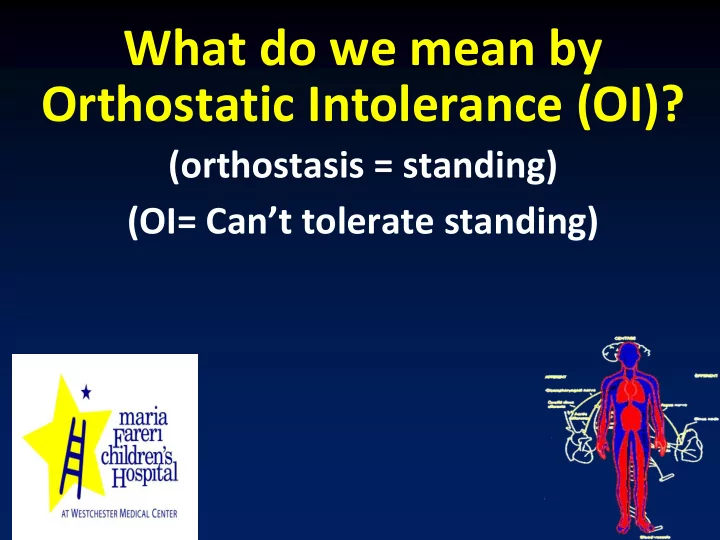

What do we mean by Orthostatic Intolerance (OI)? (orthostasis = standing) (OI= Can’t tolerate standing)
Hard to Define but I know it when I see it? Pediatric Group Definitions Orthostatic Intolerance The presence of one or more symptoms, e. g., lightheadedness, dizziness, nausea, breathlessness, and vision change, linked specifically to assuming or maintaining upright posture, and symptoms abate once supine No mention of etiology; All Symptoms; Include Balance, Positional Vertigo, Postural Headache, Musculoskeletal Diseases? Chronic Orthostatic Intolerance On-going Orthostatic Intolerance for at least 3 months with functional impairment POTS Chronic Orthostatic Intolerance with excessive postural tachycardia (at least 40 bpm change within 10 minutes on standardized passive tilt testing) in the absence of an alternative explanation. A physiological response or a disease? If disease then if a specific cause is found (e.g. Addison’s Disease) it is no longer called POTS .
Consequence of Upright Stance But that’s how we are designed Gravitational Blood Distribution in Man and Beast
But Gravitational Deconditioning Occurs when Arteries, Veins, Heart and Viscera are at the same level Bed Rest (simulated microgravity) • Bed Rest (simulated microgravity) • True Microgravity • True Microgravity •
Gravitational Deconditioning • Reduced blood volume • Different Regional blood volume redistribution • Reduction in the response to norepinephrine/MSNA (and other pressors) • Cardiovascular remodeling
Circulatory Specializations for Orthostasis • Physical forces (muscle/abd –resp pump) • Vascular structure and Blood volume • Vascular regulation of O 2 Delivery • Rapid • ANS–Sympathetic/Parasymp • Myogenic • Flow Mediated Most of OI= • Slower Abnormalities in adrenergic regulation • Setting the tonic milieu –NO/Ang and the modulation of • autocrine, paracrine, endocrine adrenergic • Metabolic vasoconstriction in humans • Gene expression -> Epigenetics
Normal Circulatory Response to Orthostasis Why should this be? Why not design for full compensation to gravity?
Orthostatic Intolerance: defined by inability to tolerate the upright posture relieved by recumbence • Loss of Consciousness • Lightheadedness-Dizziness cerebral • Neurocognitive Deficit perfusion abnormalities • Headache despite cerebral autoregulation • Fatigue – worst post-ictal • Orthostatic Hypotension/Hypertension • Weakness – peripheral malperfusion? ↓↑ Adrenergic • Nausea/abdominal pain vasoconstriction • Sweating, tremulousness Parasympathetic ↓↑ • Exercise Intolerance
Orthostatic Hypotension (OH) is Easy to Understand •Blood pressure falls sufficiently to impair brain blood flow 120 Arterial Pressure (mmHg) AP 80 •Non-neurogenic OH 40 • Hypovolemia or Forced Vasodilation 0 0 100 200 300 400 HR 150 Heart Rate (bpm) 100 •Neurogenic OH 50 0 100 200 300 400 • Autonomic vasoconstrictor failure Time (sec) due to inadequate release of norepinephrine from sympathetic vasomotor neurons.
OI without OH – POTS and Presyncope Why can’t we tolerate the upright position? • Loss of Consciousness Cerebral • Lightheadedness-Dizziness Malperfusion • Neurocognitive Loss
75 o Decreased Cerebral Blood Flow? 60 o 45 o 30 o Molteni et al J. Biomed. Opt . 17(5), 056005 (May 04, 2012). 15 o 0 o Incremental Tilt JS
Mean Cerebral Blood Flow Decreased Equally in POTS and Controls 80 Cerebral Blood Flow Velocity (cm/sec) Control POTS 70 60 50 0 15 30 45 60 Tilt Angle (degrees) This should not be happening!
Cerebral Autoregulation CBF is independent of changes in blood pressure over a wide range of pressure during hypotension But not BP when Standing CBF ! CBF BP 140 During Hemorrhage During 105 g) ( mmH Hemorrhage 70 P MA 35 During Tilt 0 0 100 200 300 400 500 600 in healthy CBF is 120 volunteer maintained 90 Fv ( cm/ s) 60 B C 30 JS 0 0 100 200 300 400 500 600 Ti me ( seconds)
Recommend
More recommend